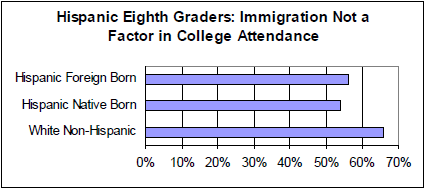In the United States today people with more education tend to live longer and healthier lives, remain married longer and earn more money. Latinos are the least-well educated segment of the American population. That’s because millions of adult immigrants with little education have arrived in recent decades. Still, native Latinos trail their white peers. High school drop out rates and low levels of college attendance pose critical challenges. Poor school resources compound a need for Hispanics to start early and complete more schooling.
Natives More Educated Than Immigrants
Among adult whites, 89 percent finish high school and nearly 30 percent a college degree. Among Hispanics only 57 percent finish high school and about 10 percent earn a college degree. But, these averages are deceptive. More than half of Latino adults are first generation, i.e. foreign-born immigrants. Few arrive young enough to attend U.S. schools. But 73 percent of U.S.-born Latino adults finish high school, 40 percent obtain some college education, and 14 percent earn at least a four-year degree.
Dropping In and Out of High School
Native versus immigrant experiences are critically different when it comes to high school completion, the greatest educational difficulty facing Hispanic children. Only about 7 percent of white children drop out. The statistics suggest that about 15 percent of native Latino children drop out compared with 44 percent of immigrant children. For some Latino immigrants this reflects their experience in U.S. schools, but many others, especially those who arrive as older adolescents, never “drop in,” that is they go straight to work while their American peers are still studying. The Department of Education finds that more than half of Latino immigrant dropouts never enroll in schools here. However, immigrant children arriving before the eighth grade do much better in U.S. schools. These youngsters have an easier time adjusting and go on to finish high school and reach college at rates similar to native Latino children.
Enrolling and Enrolling Early in Four-Year Colleges
Latino high school students are less likely to pursue postsecondary education than their white peers. Only part of this gap is due to differences in high school graduation rates. Eighty two percent of graduating Latino high school seniors with college qualifications go on to postsecondary education compared with eighty nine percent of whites. Latino high school grads tend to wait some time before going on to higher education, and many able students choose two-year colleges rather than bachelor’s degree institutions. The likelihood of obtaining a degree is vastly improved if the student immediately goes on to college; delayed entrants get sidetracked.
The Early Years: “Learning Begets Learning”
Some of the problems that become apparent among Latinos in high school and college stem from early academic difficulties. Achievement test scores suggest that the average Latino child is about two grades behind the average white child by age 9. Growing recognition of the importance of early learning has stimulated a surge in preschool and nursery school enrollment in recent decades, but such programs are nowhere near universal. About 55 percent of white 3-to 4-year-olds are enrolled compared with 35 percent of Latinos the same ages. Part of the gap can be explained by the fact that a greater proportion of white mothers with young children work. However, affordability is also a barrier. In most jurisdictions nursery school is not part of the regular public school programs, and parents must pay for it.
Poor School Resources and the Future
Several different indicators can be used to measure conditions that contribute to academic achievement. Nine percent of white children are enrolled in minority predominant school districts, in comparison with two-thirds of Latino children. Latino youth are concentrated in central cities and thus are most likely to attend schools that are overcrowded and underfunded. In California, for example, about 16 percent of the teachers in schools attended by Hispanics are not fully credentialed, twice the percentage for schools attended by whites.


